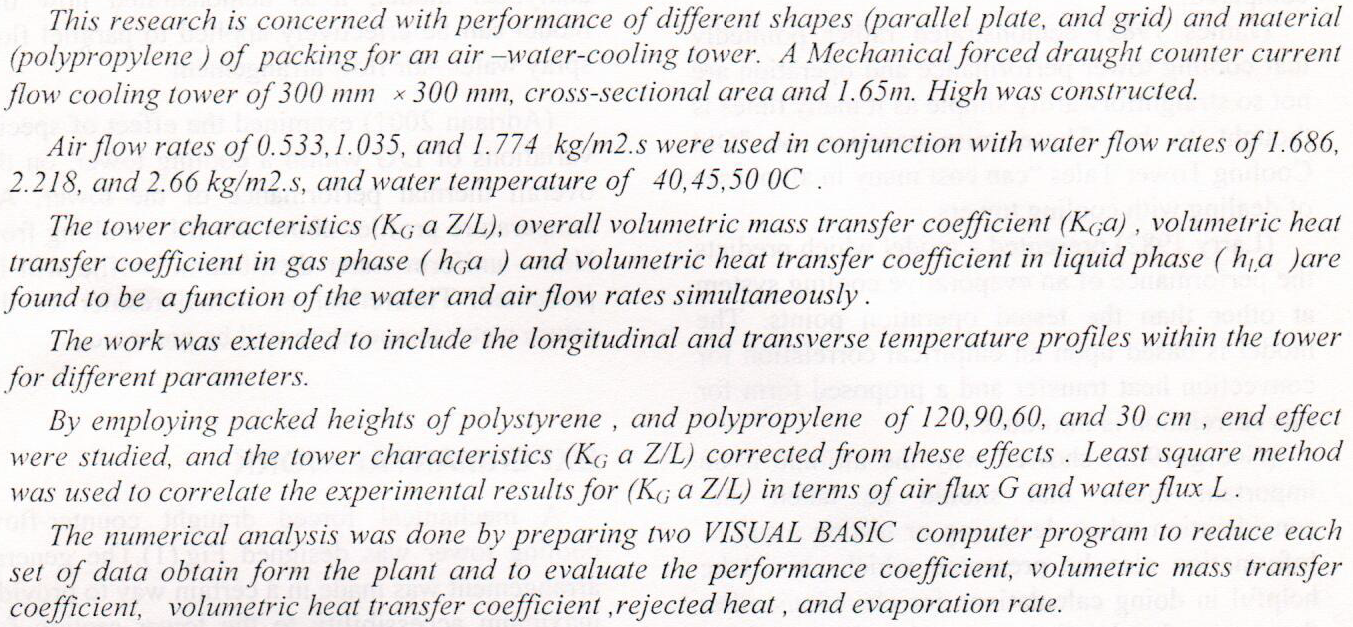
A load flow program is developed using MATLAB and based on the Newton–Raphson method,which shows very fast and efficient rate of convergence as well as computationally the proposed method is very efficient and it requires less computer memory through the use of sparsing method and other methods in programming to accelerate the run speed to be near the real time.
The designed program computes the voltage magnitudes and phase angles at each bus of the network under steady–state operating conditions. It also computes the power flow and power losses for all equipment, including transformers and transmission lines taking into consideration the effects of off–nominal, tap and phase shift transformers, generators, shunt capacitors, sh
Permeability determination in Carbonate reservoir is a complex problem, due to their capability to be tight and heterogeneous, also core samples are usually only available for few wells therefore predicting permeability with low cost and reliable accuracy is an important issue, for this reason permeability predictive models become very desirable.
This paper will try to develop the permeability predictive model for one of Iraqi carbonate reservoir from core and well log data using the principle of Hydraulic Flow Units (HFUs). HFU is a function of Flow Zone Indicator (FZI) which is a good parameter to determine (HFUs).
Histogram analysis, probability analysis and Log-Log plot of Reservoir Qua
... Show MoreThe air flow pattern in a co-current pilot plant spray dryer fitted with a rotary disk atomizer was determined experimentally and modelled numerically using Computational Fluid Dynamics (CFD) (ANSYS Fluent ) software. The CFD simulation used a three dimensions system, Reynolds-Average Navier-Stokes equations (RANS), closed via the RNG k −ε turbulence model. Measurements were carried out at a rotation of the atomizer (3000 rpm) and when there is no rotation using a drying air at 25 oC and air velocity at the inlet of 5 m/s without swirl. The air flow pattern was predicted experimentally using cotton tufts and digital anemometer. The CFD simulation predicted a downward central flowing air core surrounded by a slow
... Show More (22)
(22)
 (16)
(16)
This paper investigates the effect of magnetohydrodynamic (MHD) of an incompressible generalized burgers’ fluid including a gradient constant pressure and an exponentially accelerate plate where no slip hypothesis between the burgers’ fluid and an exponential plate is no longer valid. The constitutive relationship can establish of the fluid model process by fractional calculus, by using Laplace and Finite Fourier sine transforms. We obtain a solution for shear stress and velocity distribution. Furthermore, 3D figures are drawn to exhibit the effect of magneto hydrodynamic and different parameters for the velocity distribution.
 (3)
(3)
 (1)
(1)
A novel analytical method is developed for the determination of azithromycin. The method utilizes continuous flow injection analysis to enhance the chemiluminescence system of luminol, H2O2, and Cr(III). The method demonstrated a linear dynamic range of 0.001–100 mmol L-1 with a high correlation coefficient (r) of 0.9978, and 0.001–150 mmol L-1 with a correlation coefficient (r) of 0.9769 for the chemiluminescence emission versus azithromycin concentration. The limit of detection (L.O.D.) of the method was found to be 18.725 ng.50 µL−1 based on the stepwise dilution method for the lowest concentration within the linear dynamic range of the calibration graph. The relative standard deviation (R.S.D. %) for n = 6 was less than 1.2%
... Show More (1)
(1)
 (1)
(1)
Background: Several pathologies of the oral cavity have been associated with stress. Dental students need to gain assorted proficiencies as theoretical knowledge, clinical proficiencies, and interpersonal dexterity which is accompanied with high level of stress. Uric acid is the major antioxidant in saliva. The aim of this study is to assess the dental caries experience among dental students with different levels of dental environment stress in relation to physicochemical characteristics of whole unstimulated saliva.
Materials and Methods: the total sample is composed of 300 dental students (73 males, 227 female) aged 22-23 years old, from collage of dentistry / university of Baghdad, from the 4t
... Show More (7)
(7)
 (2)
(2)
Excessive water production is a persistent challenge in oil and gas wells, with polymer and gel solutions commonly employed for water control. This study investigates the rheological behaviour of cross-linked polyacrylamide gels and their impact on water shutoff treatment in gas wells. Rheological measurements, coreflooding experiments using Berea sandstone samples, and micromodel flow visualizations were conducted to evaluate gel performance. Results showed that during water injection, the water residual resistance factor ( Frrw ) decreases with increasing flow rates, mainly due to gel shear thinning behaviour and reduced residual gas saturation. Higher polymer concentrations in the gel enhance water permeability reduction. In contrast, un
... Show More (16)
(16)
 (12)
(12)
Chromatographic and spectrophotometric methods for the estimation of mebendazole in
pharmaceutical products were developed. The flow injection method was based on the oxidation of
mebendazole by a known excess of sodium hypochlorite at pH=9.5. The excess sodium hypochlorite is then
reacted with chloranilic acid (CAA) to bleach out its color. The absorbance of the excess CAA was recorded
at 530 nm. The method is fast, simple, selective, and sensitive. The chromatographic method was carried out
on a Varian C18 column. The mobile phase was a mixture of acetonitrile (ACN), methanol (MeOH), water
and triethylamine (TEA), (56% ACN, 20% MeOH, 23.5% H2O, 0.5% TEA, v/v), adjusted to pH = 3.0 with
1.0 M hy
 (4)
(4)
 (2)
(2)
